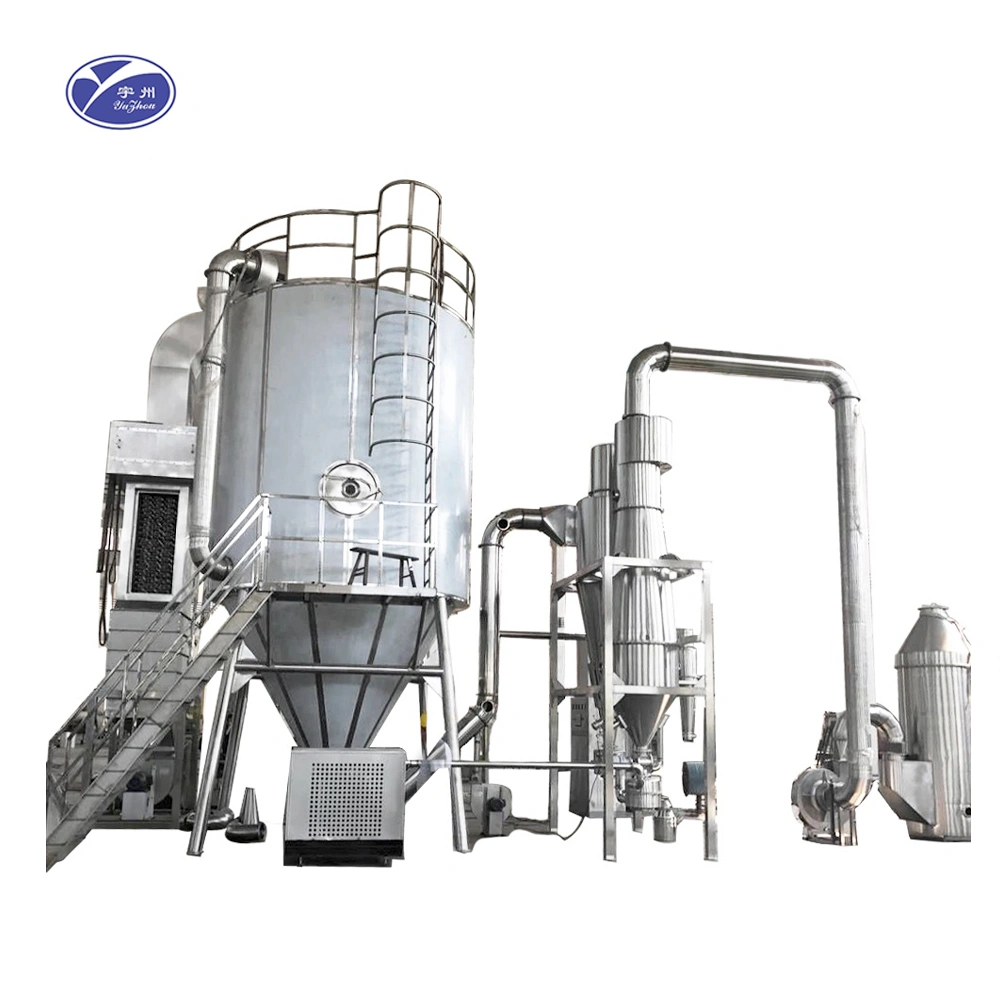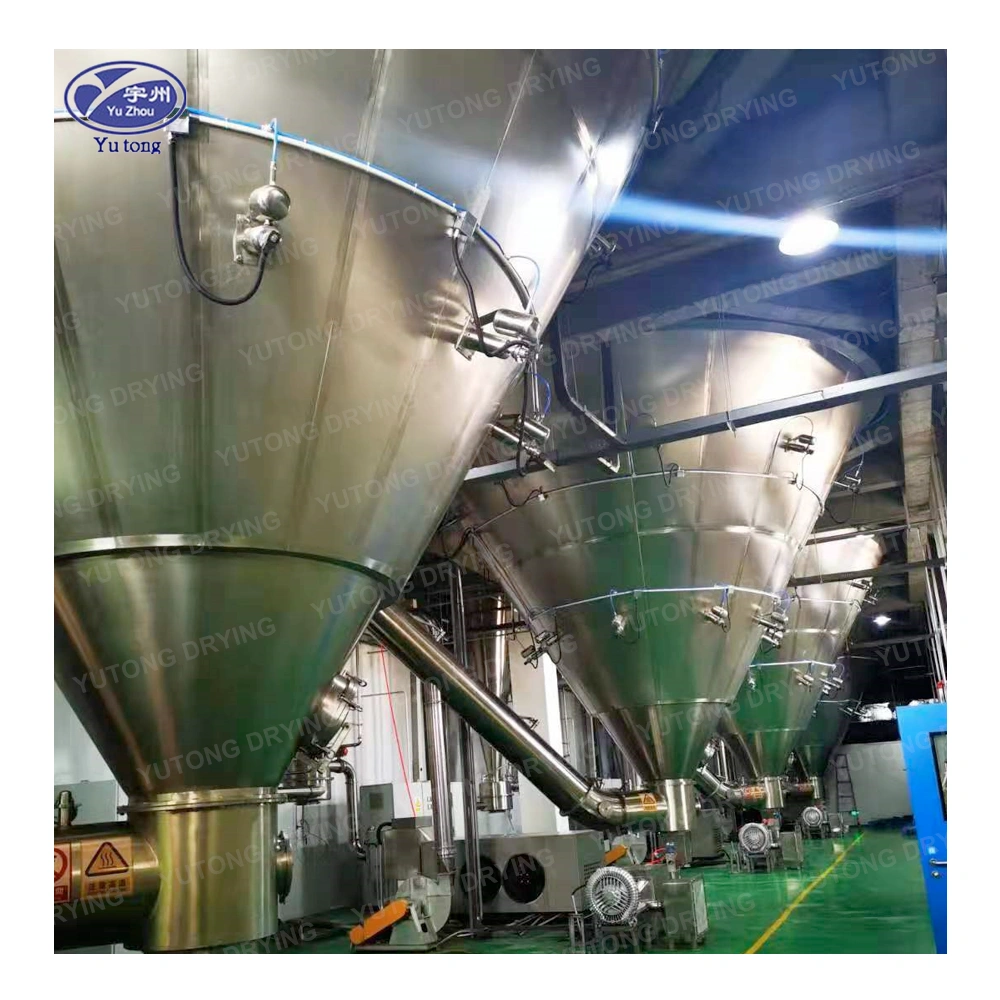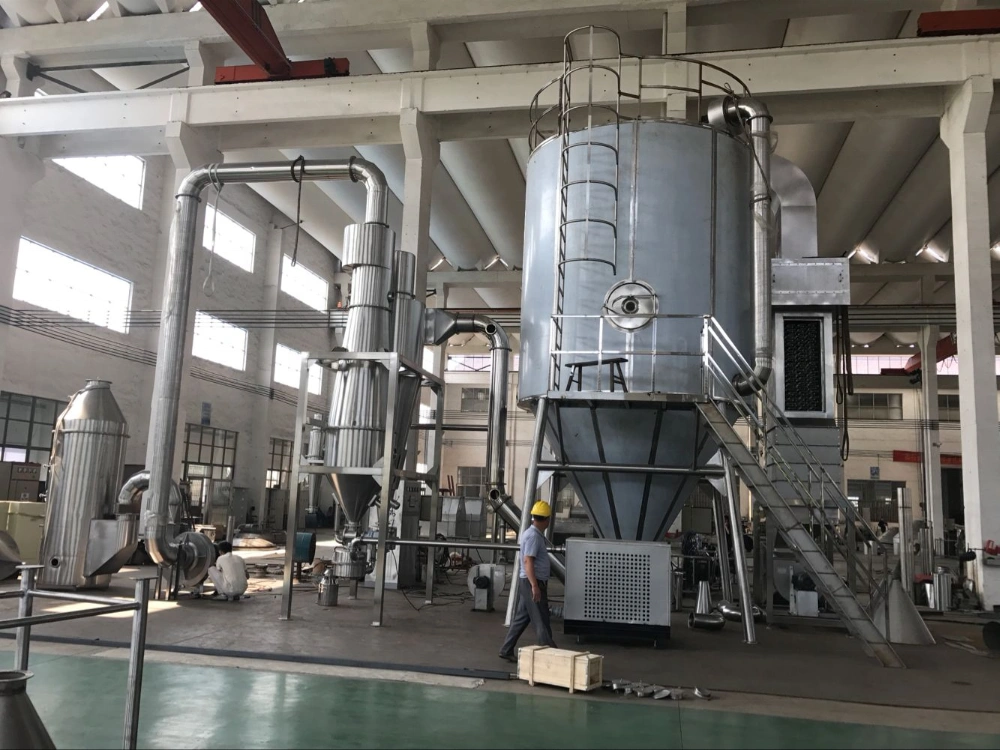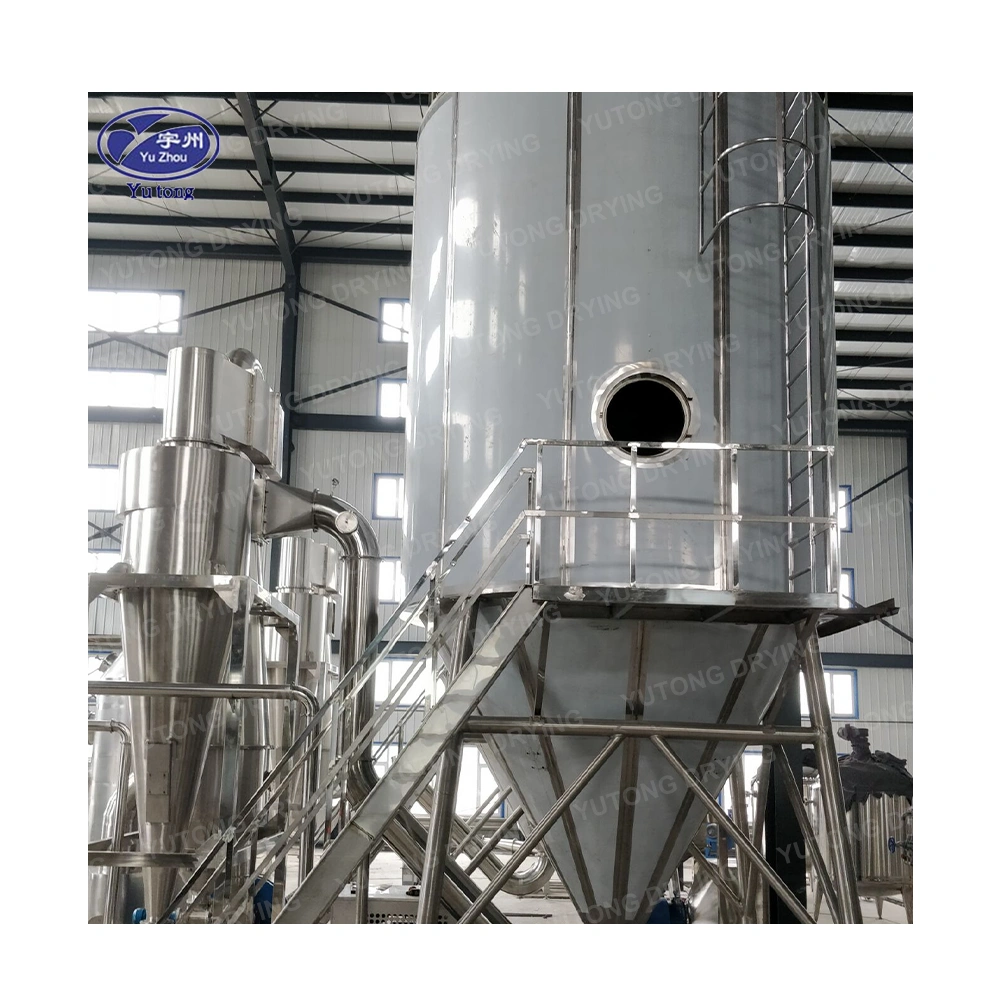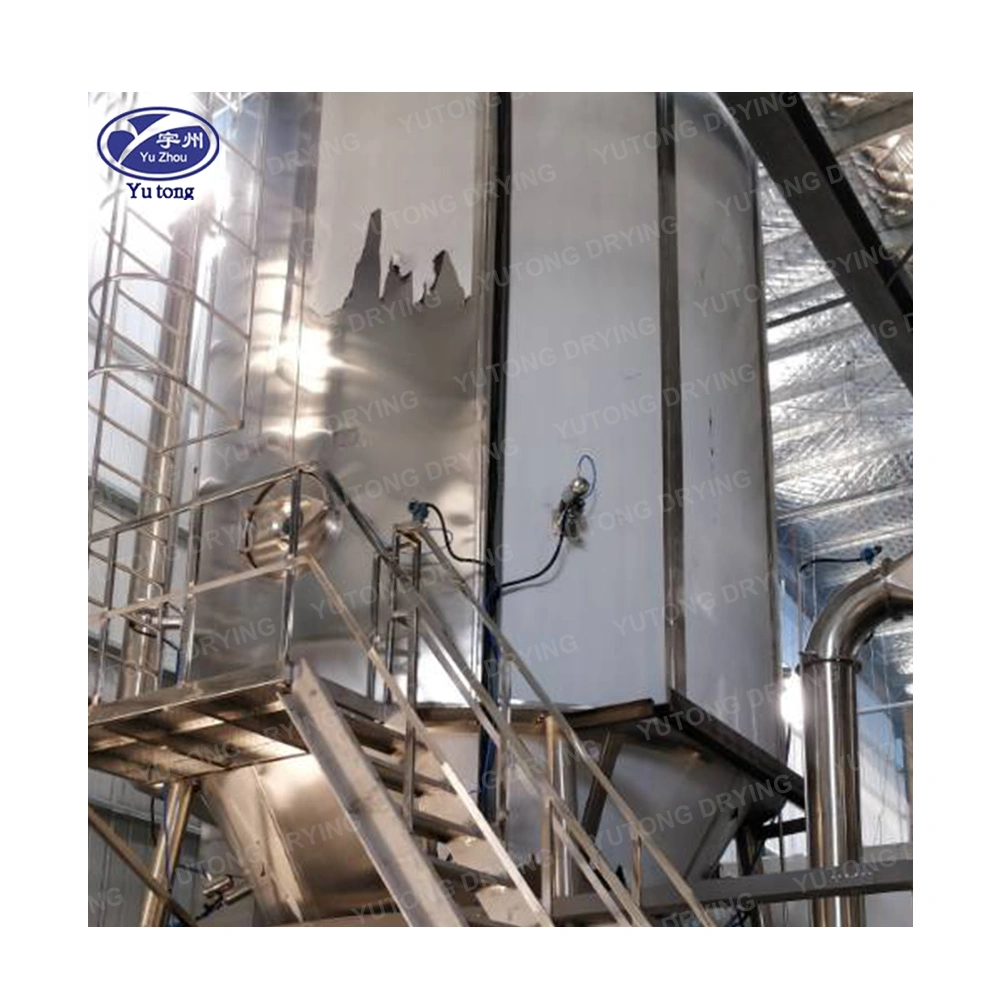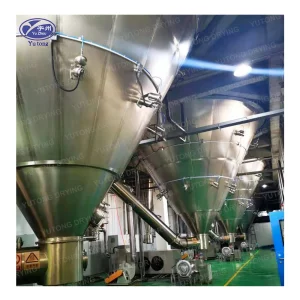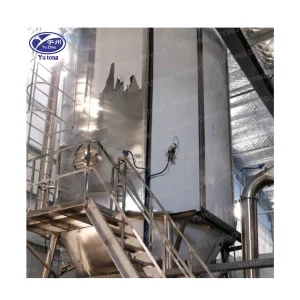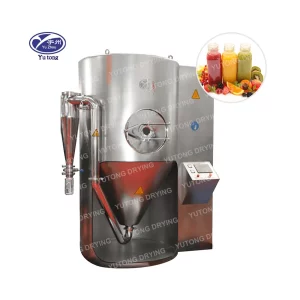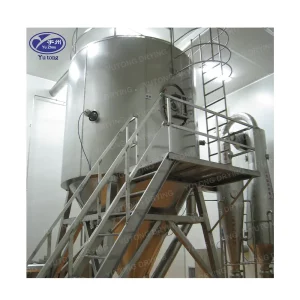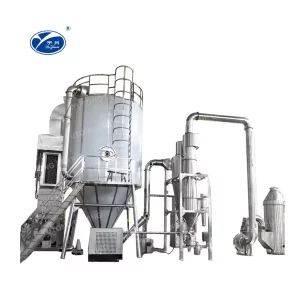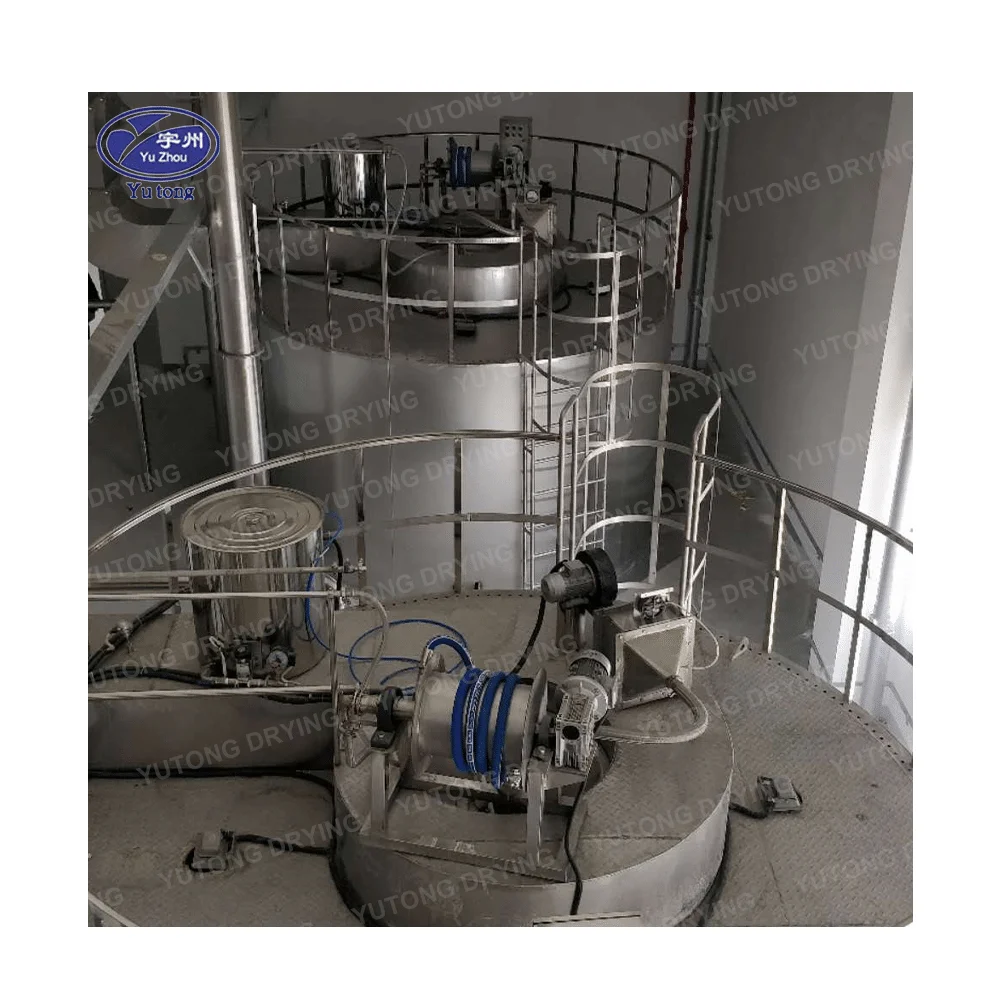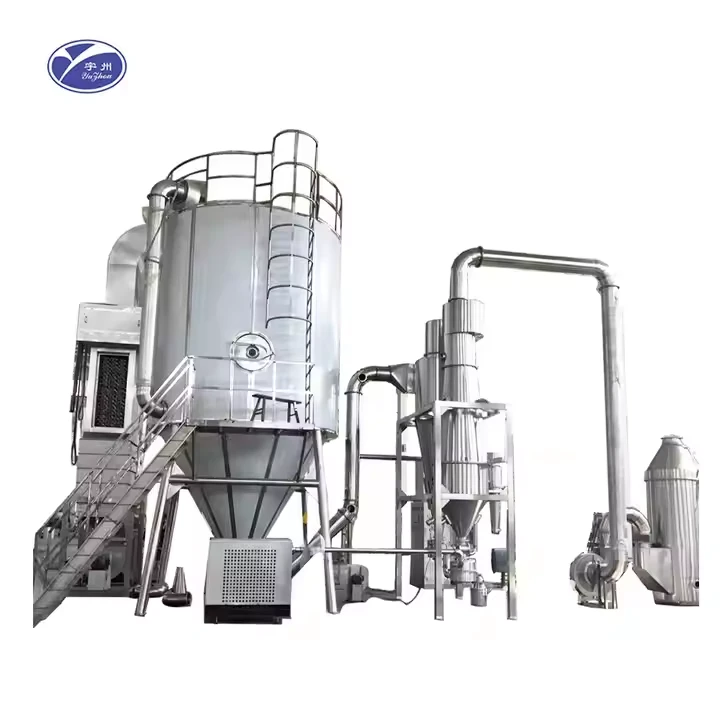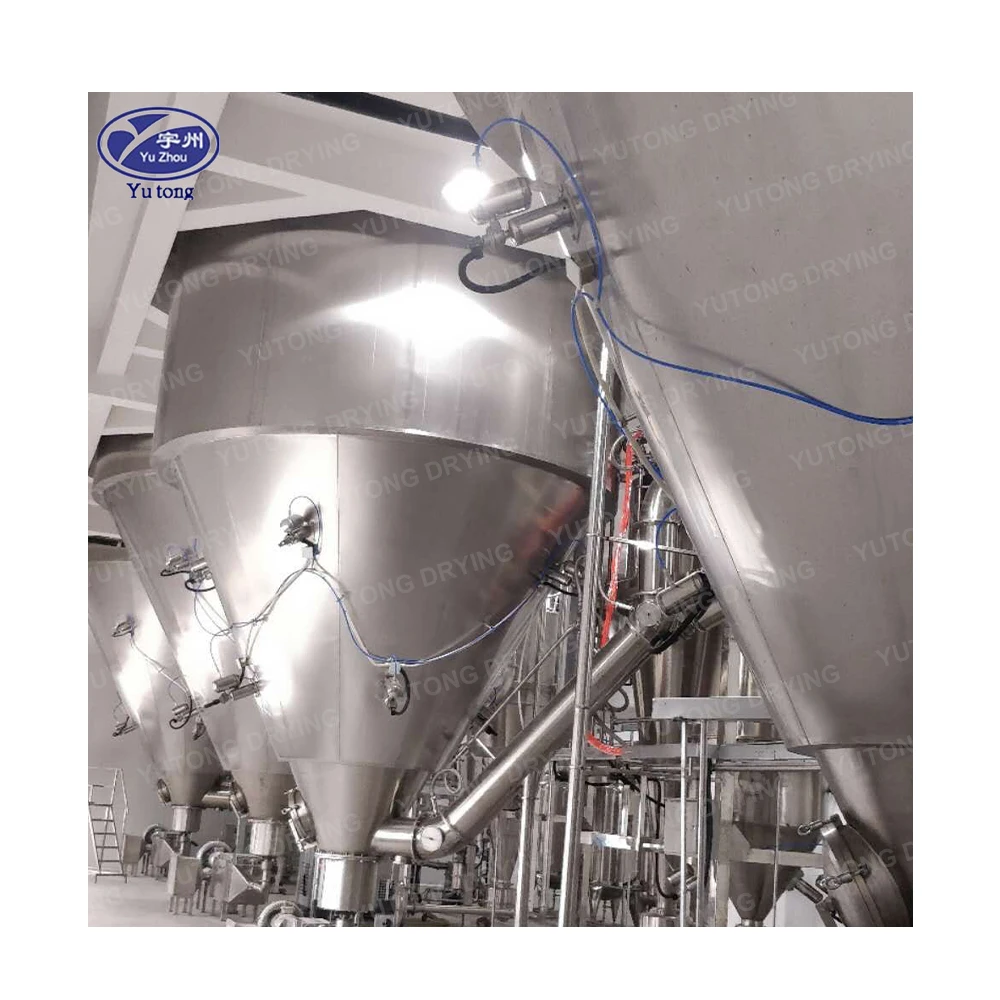
Оглавление
Подробности продукта
Основной принцип: высокоскоростное центрифужное распыление для экстракта традиционной китайской медицины является применением техники центрифужного распыления. Он также использует высокоскоростной распылитель для превращения жидкого материала в туманные капли для полного контакта с горячим воздухом для завершения мгновенной сушки и получения конечного порошкообразного продукта.
Основные характеристики1) Корпус башни оснащен рубашкой охлаждения воздуха для снижения температуры внутри башни и устранения явления предварительного нагрева и размягчения продукта.
2) Распылитель наверху башни оснащен охлаждающим устройством для снижения температуры распылителя, в то же время эффективно устраняя возврат материала наверх в вихревых токах и предотвращая явление коксования предварительного нагрева3) Корпус башни и трубопровод оснащены ручным быстрооткрывающимся отверстием для очистки и дренажным отверстием. При необходимости также может быть установлено устройство автоматической очистки ClP.
4) Может быть оборудован автоматическим регулятором постоянной температуры питающего бака.
5) Ручные моечные инструменты высокого давления могут быть предложены в качестве дополнительных принадлежностей вместе с распылительной сушилкой. 6) Все детали, контактирующие с продуктом, изготовлены из нержавеющей стали (или все детали из нержавеющей стали). 7) Для сбора продукта используются двухступенчатые циклоны и пылеуловитель с водяной пленкой.
8) Температура воздуха на входе контролируется автоматически и непрерывно, что связано с подачей. 9) Устройство для поддува воздуха может быть опциональным для некоторых продуктов.
распылительная сушилка для осины
Когда дело доходит до процессов сушки в химической и фармацевтической промышленности, распылительная сушка является важнейшим методом. Она преобразует жидкие вещества в порошкообразную форму путем быстрой сушки горячим газом. В этой статье рассматривается Aspen Spray Dryer, ее значение и то, как моделировать вакуумную сушилку в Aspen Plus — мощном программном обеспечении для моделирования процессов.
Понимание распылительной сушки
Распылительная сушка — это метод, при котором жидкость преобразуется в сухой порошок путем распыления ее в горячем сушильном средстве. Этот процесс необходим для производства высококачественных порошков из растворов или суспензий. Результатом является сыпучий порошок с определенным размером частиц, содержанием влаги и насыпной плотностью.
Наука, лежащая в основе распылительной сушки
Распылительная сушка включает в себя несколько сложных физических и химических процессов. Жидкий материал распыляется для создания крошечных капель, которые затем подвергаются воздействию горячей сушильной среды. По мере того, как капли движутся через сушильную камеру, они быстро теряют влагу. Разница температур между поверхностью капли и сушильным газом приводит к удалению влаги.
Такие факторы, как размер капель, температура сушки и скорость потока воздуха, влияют на процесс. Понимание этих переменных необходимо для управления скоростью сушки и обеспечения качества продукта. Температура капель, скорость воздуха и уровень влажности являются критическими параметрами, которые необходимо оптимизировать для эффективной сушки.
Исторический контекст и эволюция
Технология распылительной сушки значительно развилась с момента своего появления. Первоначально разработанная для молочной промышленности, она распространилась на фармацевтическую, химическую и пищевую промышленность. Технологические достижения в распылительной сушке привели к повышению энергоэффективности, качества продукции и эксплуатационной гибкости.
За эти годы такие инновации, как конструкция сопла, конфигурации сушильной камеры и системы рекуперации тепла, улучшили процесс. Эти достижения позволили производить широкий ассортимент продукции с различными характеристиками. Постоянное развитие в этой области было обусловлено потребностью в более устойчивых и экономически эффективных методах сушки.
Современные приложения и инновации
В современных отраслях промышленности распылительная сушка используется для производства порошкообразных форм продуктов с точными характеристиками. Она широко применяется при создании растворимого кофе, сухого молока, моющих средств и фармацевтических вспомогательных веществ. К последним инновациям относится разработка методов распылительной сушки для термочувствительных материалов и нутрицевтиков.
Новые технологии, такие как нанораспылительная сушка и инкапсуляция, расширяют сферу применения. Эти достижения прокладывают путь для более специализированных приложений, включая биотехнологии и передовые материалы. Поскольку отрасли продолжают требовать более высокого качества и эффективности, технология распылительной сушки, несомненно, продолжит развиваться.
Компоненты распылительной сушилки
Типичная распылительная сушилка состоит из:
- Распылитель: преобразует жидкость в мелкие капли. Распылитель является сердцем системы распылительной сушки, определяя размер и распределение капель. Различные типы распылителей, такие как роторные и сопловые распылители, используются в зависимости от требований к продукту.
- Сушильная камера: Здесь капли контактируют с горячим газом. Конструкция сушильной камеры влияет на время пребывания и эффективность теплопередачи. Она должна быть тщательно спроектирована, чтобы предотвратить агломерацию и обеспечить равномерную сушку.
- Циклонный сепаратор: Отделяет высушенные частицы от отработанного воздуха. Циклонный сепаратор имеет решающее значение для извлечения высушенного порошка и минимизации потерь продукта. Его эффективность определяется размером частиц и конструктивными параметрами циклона.
- Коллектор: собирает конечный порошкообразный продукт. Система коллектора должна быть спроектирована так, чтобы аккуратно обращаться с порошком, чтобы избежать его деградации. Она может включать мешочные фильтры или электростатические осадители для сбора мелких частиц.
Преимущества распылительной сушки
Распылительная сушка имеет множество преимуществ, таких как:
- Производство однородных размеров частиц. Постоянный размер частиц имеет решающее значение для производительности и качества продукта. Он влияет на скорость растворения, текстуру и внешний вид конечного продукта.
- Контроль содержания влаги. Контроль содержания влаги необходим для стабильности продукта и срока годности. Распылительная сушка позволяет точно контролировать конечное содержание влаги, что жизненно важно для предотвращения роста микроорганизмов и порчи.
- Повышение стабильности и срока годности продуктов. Снижая содержание влаги, распылительная сушка помогает повысить стабильность продукта. Она также защищает чувствительные ингредиенты от деградации из-за окисления или гидролиза.
Aspen Plus и распылительная сушка
Aspen Plus — это инструмент моделирования процессов, широко используемый в химической инженерии. Он позволяет инженерам моделировать процессы, оптимизировать конструкции и прогнозировать производительность. Моделирование распылительной сушилки в Aspen Plus включает настройку процесса с использованием встроенных в него операций и термодинамических моделей.
Введение в Aspen Plus
Aspen Plus — это комплексная среда моделирования процессов, широко используемая в различных отраслях. Она предлагает широкий спектр возможностей моделирования для проектирования и оптимизации химических процессов. Благодаря передовым инструментам моделирования инженеры могут прогнозировать поведение сложных систем и принимать обоснованные решения.
Программное обеспечение предоставляет библиотеку операций, термодинамических моделей и базы данных физических свойств. Эти функции позволяют точно моделировать такие процессы, как распылительная сушка, дистилляция и кристаллизация. Aspen Plus является ценным инструментом как для исследовательских, так и для промышленных приложений.
Шаги по моделированию распылительной сушилки в Aspen Plus
- Определите поток процесса: создайте схему потока, которая включает все соответствующее оборудование и потоки. Этот шаг включает определение всех входов, выходов и промежуточных стадий в процессе. Четко определенный поток процесса имеет решающее значение для точных результатов моделирования.
- Свойства входного материала: введите физические и химические свойства исходного материала. Точность этих свойств напрямую влияет на надежность моделирования. Важно использовать точные данные для фазового поведения, теплоемкости и других критических свойств.
- Выберите операции блока: выберите операцию блока распылительной сушки из библиотеки Aspen. Выбор соответствующих операций блока имеет решающее значение для точного моделирования процесса распылительной сушки. Aspen Plus предлагает различные конфигурации для удовлетворения различных требований к сушке.
- Настройте рабочие условия: задайте такие параметры, как температура на входе, давление и скорость потока. Эти условия должны быть оптимизированы для обеспечения эффективной сушки и качества продукта. Понимание взаимодействия между этими переменными является ключом к успешному моделированию.
- Запустите симуляцию: запустите модель для анализа процесса сушки. Запуск симуляции позволяет инженерам оценить производительность процесса и определить потенциальные улучшения. Она дает представление о потреблении энергии, выходе продукта и эффективности эксплуатации.
Ключевые соображения при моделировании
- Термодинамические данные: Точные данные имеют решающее значение для точных результатов моделирования. Выбор соответствующих термодинамических моделей влияет на точность фазовых равновесий и прогнозов теплопередачи.
- Распределение размеров капель: влияет на скорость сушки и качество конечного продукта. Распределение размеров капель влияет на площадь поверхности, доступную для тепло- и массопереноса. Это критический параметр для оптимизации процесса сушки.
- Тепло- и массопередача: Должна быть точно смоделирована для надежных прогнозов. Понимание механизмов тепло- и массопередачи необходимо для точного моделирования поведения сушки. Оно включает в себя сложные взаимодействия между средой сушки и каплями.
Моделирование вакуумной сушилки в Аспене
Вакуумная сушилка работает при пониженном давлении, что снижает температуру кипения жидкости. Это полезно для сушки термочувствительных материалов. Моделирование вакуумной сушилки в Aspen Plus требует особого внимания к настройкам давления и поведению материала в условиях вакуума.
Как работает вакуумная сушка
Вакуумная сушка — это метод сушки материалов при более низких температурах. За счет снижения давления окружающей среды температура кипения жидкости снижается, что позволяет проводить бережную сушку. Это особенно полезно для сохранения целостности термочувствительных веществ.
Процесс включает создание вакуума в сушильной камере, что облегчает удаление влаги. Среда пониженного давления ускоряет процесс сушки, сводя к минимуму термическую деградацию. Вакуумная сушка обычно используется для фармацевтических препаратов, пищевых продуктов и специальных химикатов.
Этапы моделирования вакуумной сушилки
- Выберите соответствующие модули: используйте модули вакуумной сушки Aspen или настройте модель сушилки. Выбор модуля зависит от конкретных требований к сушке и свойств материала. Aspen Plus предлагает гибкость в настройке пользовательских моделей для уникальных приложений.
- Установите условия вакуума: отрегулируйте настройки давления для имитации условий вакуума. Точный контроль давления необходим для достижения желаемой скорости сушки и качества продукта. Он требует точной калибровки вакуумной системы и постоянного мониторинга.
- Входные данные о материалах: убедитесь, что данные отражают поведение материалов при низких давлениях. Свойства материалов, такие как давление паров, теплоемкость и теплопроводность, должны быть точно определены. Эти свойства влияют на кинетику сушки и потребности в энергии.
- Анализ результатов: Оцените время сушки, потребление энергии и качество продукта. Результаты моделирования дают представление об эффективности процесса и потенциальных областях для улучшения. Это позволяет инженерам оптимизировать условия сушки и минимизировать потребление энергии.
Проблемы моделирования вакуумной сушилки
- Контроль давления: Поддержание стабильного уровня вакуума может быть сложной задачей. Колебания давления могут повлиять на скорость сушки и консистенцию продукта. Для обеспечения стабильности требуются точные системы контроля и регулярное обслуживание.
- Свойства материалов: Изменения в поведении материалов в условиях вакуума требуют тщательного рассмотрения. Различные материалы по-разному реагируют на условия вакуума, что влияет на эффективность сушки. Это требует глубокого понимания и точной характеристики свойств материалов.
Практические применения
Распылительные сушилки и вакуумные сушилки используются в различных отраслях промышленности, в том числе:
- Фармацевтика: Для производства активных фармацевтических ингредиентов (АФИ). Распылительная сушка повышает растворимость и биодоступность плохо растворимых лекарств, улучшая терапевтическую эффективность.
- Пищевая промышленность: в производстве сухого молока, кофе и специй. Вакуумная сушка сохраняет чувствительные к теплу питательные вещества и ароматы, поддерживая качество и пищевую ценность продукта.
- Химикаты: Для создания тонких порошков и гранул. Точность распылительной сушки позволяет производить однородные и высококачественные химические продукты.
Примеры отрасли
- Фармацевтика: Распылительная сушка используется для повышения растворимости и биодоступности лекарств. Она позволяет производить аморфные твердые дисперсии, улучшая скорость доставки и абсорбции лекарств.
- Обработка пищевых продуктов: Вакуумная сушка применяется для сохранения чувствительных к теплу питательных веществ и вкусов. Она используется для дегидратации фруктов, овощей и трав с сохранением их естественного цвета и вкуса.
- Химическое производство: распылительная сушка создает частицы одинакового размера и улучшает стабильность продукта. Используется в производстве катализаторов, пигментов и моющих средств для различных применений.
Заключение
Понимание тонкостей распылительной и вакуумной сушки жизненно важно для отраслей, зависящих от производства порошка. Использование Aspen Plus для моделирования этих процессов позволяет оптимизировать и повысить эффективность. Благодаря точному моделированию распылительных и вакуумных сушилок инженеры могут проектировать более эффективные процессы, сокращать затраты и повышать качество продукции.
Внедрение этих методов в ваш рабочий процесс может привести к значительному прогрессу в разработке продукции и эффективности производства. Независимо от того, работаете ли вы в фармацевтической, пищевой или химической промышленности, освоение Aspen Plus и его возможностей, несомненно, окажется полезным.
Помните, залог успешного моделирования — подробные входные данные, аккуратная настройка и тщательный анализ. Удачного моделирования!
Технические характеристики
|
спецификация
|
ЗПГ-25
|
ЗПГ-50
|
ЗПГ-80
|
ЗПГ-100
|
ЗПГ-150
|
ЗПГ-200
|
ЗПГ-300
|
|
|
Испарительная способность (кг/ч)
|
25
|
50
|
80
|
100
|
150
|
200
|
300
|
|
|
Количество обрабатываемого материала (кг/ч)
|
25-34
|
50-68
|
80-108
|
100-135
|
150-203
|
200-270
|
300-406
|
|
|
выход готового продукта(кг/ч)
|
4.8-7.2
|
9.2-14
|
14.8-22.4
|
18.4-28
|
24-42
|
36.8-56.4
|
55-85
|
|
|
Содержание твердого вещества в жидкости (%)
|
18-30
|
|||||||
|
Влажность готового продукта (%)
|
3-5
|
|||||||
|
электрическая мощность(кВт)
|
63
|
132
|
153
|
204
|
246
|
330
|
||
|
источник тепла
|
Паровой пиус электричество
|
|||||||
|
Метод сбора продукта и его эффективность
|
Циклонный мокрый пылеуловитель первой, двух или трех ступенчатых ступеней, больше или равен 95%
|
|||||||
|
автоматические контрольно-измерительные приборы и приборы
|
индикатор температуры приточного и вытяжного воздуха
|
|||||||
|
температура воздуха на входе (℃)
|
160-220
|
|||||||
|
температура воздуха на выходе (℃)
|
80-100
|
|||||||
|
Л
|
7000
|
8000
|
9800
|
11000
|
12200
|
14100
|
15000
|
|
|
габаритные размеры (мм)
|
Вт
|
4000
|
5000
|
5700
|
6200
|
7000
|
7800
|
9000
|
|
ЧАС
|
6200
|
6900
|
8000
|
8900
|
10750
|
11900
|
13000
|
|
Приложения
Применимые отрасли: магазины стройматериалов, производственные предприятия, мастерские по ремонту оборудования, фабрики по производству продуктов питания и напитков, фермы, рестораны, розничная торговля, магазины продуктов питания и напитков.

